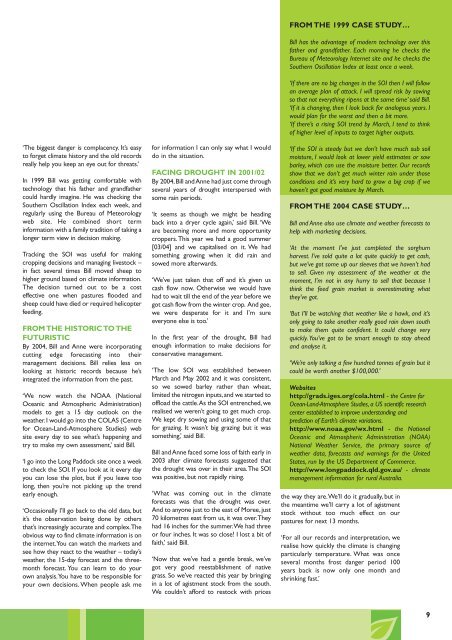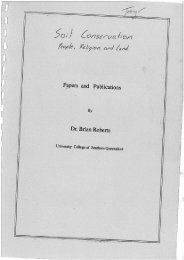Masters of the Climate: Innovative farmers ... - South West NRM
Masters of the Climate: Innovative farmers ... - South West NRM
Masters of the Climate: Innovative farmers ... - South West NRM
You also want an ePaper? Increase the reach of your titles
YUMPU automatically turns print PDFs into web optimized ePapers that Google loves.
‘The biggest danger is complacency. It’s easy<br />
to forget climate history and <strong>the</strong> old records<br />
really help you keep an eye out for threats.’<br />
In 1999 Bill was getting comfortable with<br />
technology that his fa<strong>the</strong>r and grandfa<strong>the</strong>r<br />
could hardly imagine. He was checking <strong>the</strong><br />
Sou<strong>the</strong>rn Oscillation Index each week, and<br />
regularly using <strong>the</strong> Bureau <strong>of</strong> Meteorology<br />
web site. He combined short term<br />
information with a family tradition <strong>of</strong> taking a<br />
longer term view in decision making.<br />
Tracking <strong>the</strong> SOI was useful for making<br />
cropping decisions and managing livestock –<br />
in fact several times Bill moved sheep to<br />
higher ground based on climate information.<br />
The decision turned out to be a cost<br />
effective one when pastures flooded and<br />
sheep could have died or required helicopter<br />
feeding.<br />
FROM THE HISTORIC TO THE<br />
FUTURISTIC<br />
By 2004, Bill and Anne were incorporating<br />
cutting edge forecasting into <strong>the</strong>ir<br />
management decisions. Bill relies less on<br />
looking at historic records because he’s<br />
integrated <strong>the</strong> information from <strong>the</strong> past.<br />
‘We now watch <strong>the</strong> NOAA (National<br />
Oceanic and Atmospheric Administration)<br />
models to get a 15 day outlook on <strong>the</strong><br />
wea<strong>the</strong>r. I would go into <strong>the</strong> COLAS (Centre<br />
for Ocean-Land-Atmosphere Studies) web<br />
site every day to see what’s happening and<br />
try to make my own assessment,’ said Bill.<br />
‘I go into <strong>the</strong> Long Paddock site once a week<br />
to check <strong>the</strong> SOI. If you look at it every day<br />
you can lose <strong>the</strong> plot, but if you leave too<br />
long, <strong>the</strong>n you’re not picking up <strong>the</strong> trend<br />
early enough.<br />
‘Occasionally I’ll go back to <strong>the</strong> old data, but<br />
it’s <strong>the</strong> observation being done by o<strong>the</strong>rs<br />
that’s increasingly accurate and complex.The<br />
obvious way to find climate information is on<br />
<strong>the</strong> internet.You can watch <strong>the</strong> markets and<br />
see how <strong>the</strong>y react to <strong>the</strong> wea<strong>the</strong>r – today’s<br />
wea<strong>the</strong>r, <strong>the</strong> 15-day forecast and <strong>the</strong> threemonth<br />
forecast. You can learn to do your<br />
own analysis.You have to be responsible for<br />
your own decisions. When people ask me<br />
for information I can only say what I would<br />
do in <strong>the</strong> situation.<br />
FACING DROUGHT IN 2001/02<br />
By 2004,Bill and Anne had just come through<br />
several years <strong>of</strong> drought interspersed with<br />
some rain periods.<br />
‘It seems as though we might be heading<br />
back into a dryer cycle again,’ said Bill. ‘We<br />
are becoming more and more opportunity<br />
croppers.This year we had a good summer<br />
[03/04] and we capitalised on it. We had<br />
something growing when it did rain and<br />
sowed more afterwards.<br />
‘We’ve just taken that <strong>of</strong>f and it’s given us<br />
cash flow now. O<strong>the</strong>rwise we would have<br />
had to wait till <strong>the</strong> end <strong>of</strong> <strong>the</strong> year before we<br />
got cash flow from <strong>the</strong> winter crop. And gee,<br />
we were desperate for it and I’m sure<br />
everyone else is too.’<br />
In <strong>the</strong> first year <strong>of</strong> <strong>the</strong> drought, Bill had<br />
enough information to make decisions for<br />
conservative management.<br />
‘The low SOI was established between<br />
March and May 2002 and it was consistent,<br />
so we sowed barley ra<strong>the</strong>r than wheat,<br />
limited <strong>the</strong> nitrogen inputs,and we started to<br />
<strong>of</strong>fload <strong>the</strong> cattle.As <strong>the</strong> SOI entrenched, we<br />
realised we weren’t going to get much crop.<br />
We kept dry sowing and using some <strong>of</strong> that<br />
for grazing. It wasn’t big grazing but it was<br />
something,’ said Bill.<br />
Bill and Anne faced some loss <strong>of</strong> faith early in<br />
2003 after climate forecasts suggested that<br />
<strong>the</strong> drought was over in <strong>the</strong>ir area.The SOI<br />
was positive, but not rapidly rising.<br />
‘What was coming out in <strong>the</strong> climate<br />
forecasts was that <strong>the</strong> drought was over.<br />
And to anyone just to <strong>the</strong> east <strong>of</strong> Moree, just<br />
70 kilometres east from us, it was over.They<br />
had 16 inches for <strong>the</strong> summer.We had three<br />
or four inches. It was so close! I lost a bit <strong>of</strong><br />
faith,’ said Bill.<br />
‘Now that we’ve had a gentle break, we’ve<br />
got very good reestablishment <strong>of</strong> native<br />
grass. So we’ve reacted this year by bringing<br />
in a lot <strong>of</strong> agistment stock from <strong>the</strong> south.<br />
We couldn’t afford to restock with prices<br />
FROM THE 1999 CASE STUDY…<br />
Bill has <strong>the</strong> advantage <strong>of</strong> modern technology over this<br />
fa<strong>the</strong>r and grandfa<strong>the</strong>r. Each morning he checks <strong>the</strong><br />
Bureau <strong>of</strong> Meteorology Internet site and he checks <strong>the</strong><br />
Sou<strong>the</strong>rn Oscillation Index at least once a week.<br />
‘If <strong>the</strong>re are no big changes in <strong>the</strong> SOI <strong>the</strong>n I will follow<br />
an average plan <strong>of</strong> attack. I will spread risk by sowing<br />
so that not everything ripens at <strong>the</strong> same time’ said Bill.<br />
‘If it is changing, <strong>the</strong>n I look back for analogous years. I<br />
would plan for <strong>the</strong> worst and <strong>the</strong>n a bit more.<br />
‘If <strong>the</strong>re’s a rising SOI trend by March, I tend to think<br />
<strong>of</strong> higher level <strong>of</strong> inputs to target higher outputs.<br />
‘If <strong>the</strong> SOI is steady but we don’t have much sub soil<br />
moisture, I would look at lower yield estimates or sow<br />
barley, which can use <strong>the</strong> moisture better. Our records<br />
show that we don’t get much winter rain under those<br />
conditions and it’s very hard to grow a big crop if we<br />
haven’t got good moisture by March.<br />
FROM THE 2004 CASE STUDY…<br />
Bill and Anne also use climate and wea<strong>the</strong>r forecasts to<br />
help with marketing decisions.<br />
‘At <strong>the</strong> moment I’ve just completed <strong>the</strong> sorghum<br />
harvest. I’ve sold quite a lot quite quickly to get cash,<br />
but we’ve got some up our sleeves that we haven’t had<br />
to sell. Given my assessment <strong>of</strong> <strong>the</strong> wea<strong>the</strong>r at <strong>the</strong><br />
moment, I’m not in any hurry to sell that because I<br />
think <strong>the</strong> feed grain market is overestimating what<br />
<strong>the</strong>y’ve got.<br />
‘But I’ll be watching that wea<strong>the</strong>r like a hawk, and it’s<br />
only going to take ano<strong>the</strong>r really good rain down south<br />
to make <strong>the</strong>m quite confident. It could change very<br />
quickly.You’ve got to be smart enough to stay ahead<br />
and analyse it.<br />
‘We’re only talking a few hundred tonnes <strong>of</strong> grain but it<br />
could be worth ano<strong>the</strong>r $100,000.’<br />
Websites<br />
http://grads.iges.org/cola.html - <strong>the</strong> Centre for<br />
Ocean-Land-Atmosphere Studies, a US scientific research<br />
center established to improve understanding and<br />
prediction <strong>of</strong> Earth’s climate variations.<br />
http://www.noaa.gov/wx.html - <strong>the</strong> National<br />
Oceanic and Atmospheric Administration (NOAA)<br />
National Wea<strong>the</strong>r Service, <strong>the</strong> primary source <strong>of</strong><br />
wea<strong>the</strong>r data, forecasts and warnings for <strong>the</strong> United<br />
States, run by <strong>the</strong> US Department <strong>of</strong> Commerce.<br />
http://www.longpaddock.qld.gov.au/ - climate<br />
management information for rural Australia.<br />
<strong>the</strong> way <strong>the</strong>y are.We’ll do it gradually, but in<br />
<strong>the</strong> meantime we’ll carry a lot <strong>of</strong> agistment<br />
stock without too much effect on our<br />
pastures for next 13 months.<br />
‘For all our records and interpretation, we<br />
realise how quickly <strong>the</strong> climate is changing<br />
particularly temperature. What was once<br />
several months frost danger period 100<br />
years back is now only one month and<br />
shrinking fast.’<br />
9
















